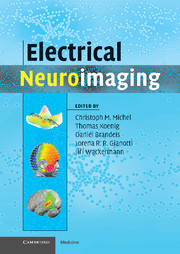Book contents
- Frontmatter
- Contents
- List of contributors
- Preface
- 1 From neuronal activity to scalp potential fields
- 2 Scalp field maps and their characterization
- 3 Imaging the electric neuronal generators of EEG/MEG
- 4 Data acquisition and pre-processing standards for electrical neuroimaging
- 5 Overview of analytical approaches
- 6 Electrical neuroimaging in the time domain
- 7 Multichannel frequency and time-frequency analysis
- 8 Statistical analysis of multichannel scalp field data
- 9 State space representation and global descriptors of brain electrical activity
- 10 Integration of electrical neuroimaging with other functional imaging methods
- Index
- References
1 - From neuronal activity to scalp potential fields
Published online by Cambridge University Press: 15 December 2009
- Frontmatter
- Contents
- List of contributors
- Preface
- 1 From neuronal activity to scalp potential fields
- 2 Scalp field maps and their characterization
- 3 Imaging the electric neuronal generators of EEG/MEG
- 4 Data acquisition and pre-processing standards for electrical neuroimaging
- 5 Overview of analytical approaches
- 6 Electrical neuroimaging in the time domain
- 7 Multichannel frequency and time-frequency analysis
- 8 Statistical analysis of multichannel scalp field data
- 9 State space representation and global descriptors of brain electrical activity
- 10 Integration of electrical neuroimaging with other functional imaging methods
- Index
- References
Summary
Introduction
The EEG, along with its event-related aspects, reflects the immediate mass action of neural networks from a wide range of brain systems, and thus provides a particularly direct and integrative noninvasive window onto human brain function. During the 80 years since the discovery of the human scalp EEG, our neurophysiological understanding of electrical brain activity has advanced at the microscopic and macroscopic level and has been linked to physical principles, as summarized in standard textbooks. The present introduction builds upon these texts but focuses on spatial aspects of EEG generators, many of which are applicable to both spontaneous and event-related activity. In particular, it is critical for the purpose of electrical neuroimaging to know which neural events are detectable at which spatial scales. As we will show, the spatial characterization of the neural EEG generators, and the advances in spatial signal processing and modeling converge in important aspects and provide a sufficiently sound basis for electrical neuroimaging. Because of the unique high temporal resolution of the EEG, electrical neuroimaging not only concerns the possible neuronal generator of the scalp potential at one given moment in time, but also the possible generators of rhythmic oscillations in different frequency ranges. In fact, understanding the intrinsic rhythmic properties of cortical or subcortical–cortical networks can help to constrain electrical neuroimaging to certain frequency ranges of interest and to perform spatial analysis in the frequency domain.
- Type
- Chapter
- Information
- Electrical Neuroimaging , pp. 1 - 24Publisher: Cambridge University PressPrint publication year: 2009
References
- 2
- Cited by



